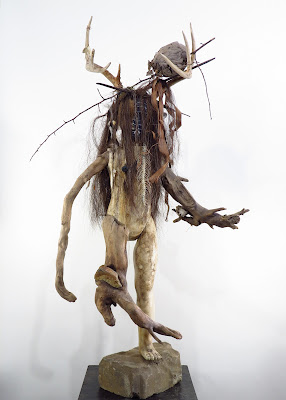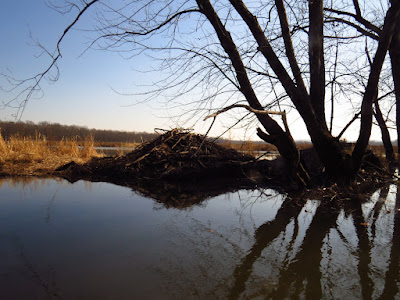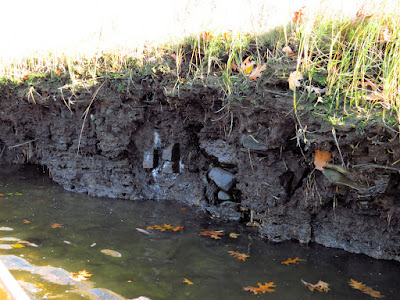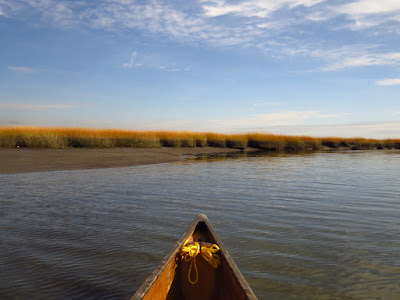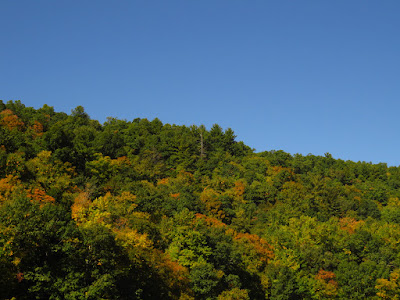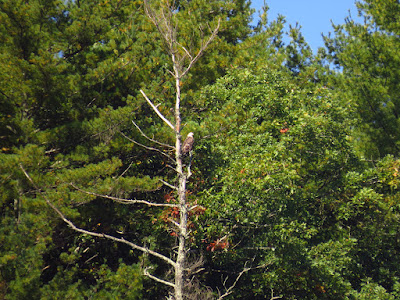I was not quite sure about canoeing today, at least not as much as I was yesterday. But, somewhere in my second cup of coffee, I figured that the trip should be less about what I would see "out there" and more about what I would see in myself.
I put in at the bottom of Salmon Cove, the mouth of the Salmon River where it enters the Connecticut River. The weatherman scored two out of three - getting the temperature and clouds correct, but missing by a mile on the wind. The prediction was 8-9 mph wind, but it was actually something right around 20 mph. Fortunately, it was coming straight down the cove. Paddling straight into such a wind is a grind, but it is easier than taking it at an angle. To be honest, I would've gone home except for two reasons - it was a 40 minute drive to get here, and my return paddle would be downwind.
 |
Bald Eagle caught singing
|
Big bird day? There are three Bald Eagles on the point just across the water as I set out - one mature, one juvenile, and one that is just in the earliest stages of maturity.
I grind the half mile up to the main cove. There is another canoe ahead of me, a good kevlar tandem, but they go to the far side of the cove and I stay to the near side hoping to get a little relief from the headwind.
I spot three more Bald Eagles, several Great Blue Herons, and there are about 50 Mute Swans. The Swans winter in the cove and there will probably be a hundred or more later in the year.
There is some protection from the wind at the top of the cove due to the surrounding hills. I head up into the Moodus River. I find the lid of a ceramic creamer in the shallows. The short Moodus River once had thirteen yarn mills on it, and so it is not unusual to find old cast offs when the water is clear.
 |
The unmaintained dam
|
Cross the beaver dam or not cross the beaver dam. Yesterday's plan had been to go someplace where I would have to deal with dams, so cross it it is. This first dam is old and no longer maintained with no change in water depth. In most river levels, it is submerged. The second beaver dam is only a hundred yards up. This dam is maintained and has a 1 foot differential in water depth. There is a hidden lodge just upriver - the old winter browse stash in the water shows where it is. There is no point in crossing this dam as a log jam blocks the river just four canoe lengths up, and the paddling ends at the Johnsonville Dam about a 1/3 of a mile further on.
I head back to the Salmon River and with the wind lessening, I decide to go up and check out Pine Brook, where there is a large patch of wild rice. I test the rice, giving a couple stalks a shake. Grains fall straight away into the canoe. If I was interested in processing wild rice, it would be a good day to harvest it. I spot several Great Blue Herons and one medium sized that i cannot identify.
 |
Wild Rice in Pine Brook
|
Getting back to the Salmon, I spot the Leesville bridge, and since the wind is even lighter now, I might as well go that far. I meet the canoeists with the kevlar canoe and have a good talk with them, giving them several tips for other day trips in the area. Then, I head up to the Leesville Dam before turning back.
 |
Wild Rice
|
I have some tailwind heading back, but the wind has clearly dropped off quite a bit.
It was a good idea to go canoeing, who'd've thunk it.












